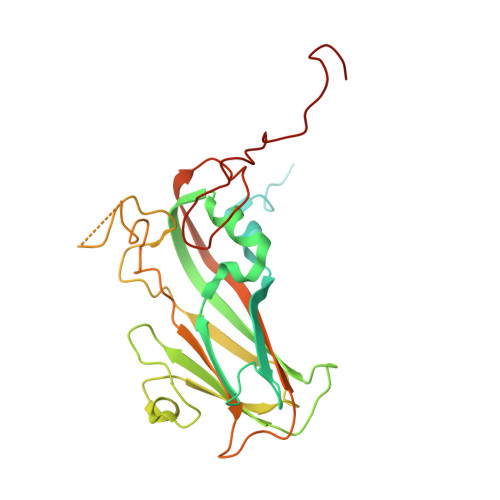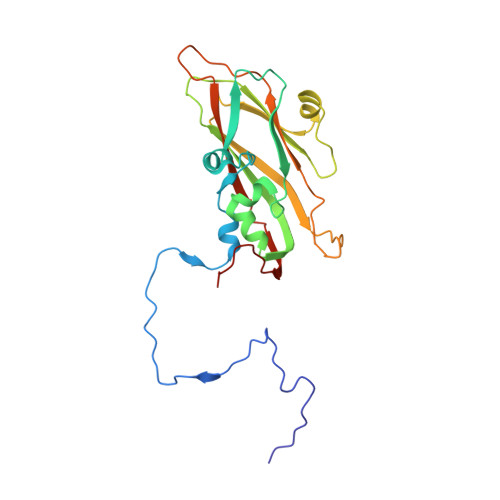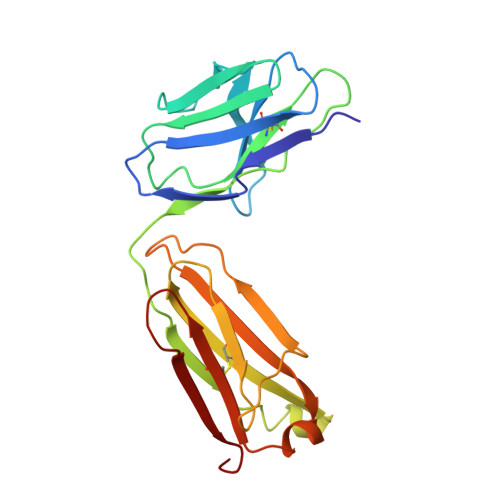Neutralization Mechanisms of Two Highly Potent Antibodies against Human Enterovirus 71.
Zhu, L., Xu, K., Wang, N., Cao, L., Wu, J., Gao, Q., Fry, E.E., Stuart, D.I., Rao, Z., Wang, J., Wang, X.(2018) mBio 9
- PubMed: 29970466
- DOI: https://doi.org/10.1128/mBio.01013-18
- Primary Citation of Related Structures:
5ZUD, 5ZUF - PubMed Abstract:
Despite significant advances in health care, outbreaks of infections by enteroviruses (EVs) continue to plague the Asia-Pacific region every year. Enterovirus 71 (EV71) causes hand-foot-and-mouth disease (HFMD), for which there are currently no therapeutics. Here, we report two new antibodies, A9 and D6, that potently neutralize EV71. A9 exhibited a 50% neutralizing concentration (neut 50 ) value of 0.1 nM against EV71, which was 10-fold lower than that observed for D6. Investigation into the mechanisms of neutralization revealed that binding of A9 to EV71 blocks receptor binding but also destabilizes and damages the virus capsid structure. In contrast, D6 destabilizes the capsid only slightly but interferes more potently with the attachment of the virus to the host cells. Cryo-electron microscopy (cryo-EM) structures of A9 and D6 bound with EV71 shed light on the locations and nature of the epitopes recognized by the two antibodies. Although some regions of the epitopes recognized by the two antibodies overlap, there are differences that give rise to dissimilarities in potency as well as in the mechanisms of neutralization. Interestingly, the overlapping regions of the epitopes encompass the site that the virus uses to bind SCARB2, explaining the reason for the observed blocking of the virus-receptor interaction by the two antibodies. We also identified structural elements that might play roles in modulating the stability of the EV71 particles, including particle integrity. The molecular features of the A9 and D6 epitopes unveiled in this study open up new avenues for rationally designing antiviral drugs. IMPORTANCE During the course of viral infections, the human body produces neutralizing antibodies which play a defining role in clearing the virus. From this study, we report two new, highly potent neutralizing antibodies, A9 and D6, against enterovirus 71 (EV71), the causative agent of HFMD. Both antibodies prevent the virus from entering the host cell, a step that is important for establishing a successful infection. A9 destabilizes and damages the virus capsid that forms an outer protective covering around the genome of the virus, while also interfering with virus attachment to the host cells. In contrast, D6 only prevents binding of the virus to its receptor(s). The mechanism of neutralization of A9 is unique and has not been observed before for neutralizing antibodies targeting EVs. The two antibodies that we are reporting in this study have potential to be developed into much-needed therapeutic interventions for treatment of HFMD, outbreaks of which are reported every year in the Asia-Pacific region.
- National Laboratory of Macromolecules, Institute of Biophysics, Chinese Academy of Sciences, Beijing, China.
Organizational Affiliation:




















